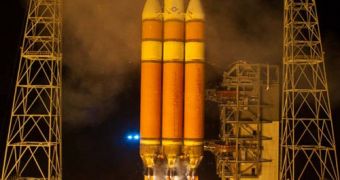Yesterday, November 21, the United States launched a new, secretive spy satellite into space, aboard a heavy-lift delivery system. The launch took place from the Cape Canaveral Air Force Station (CCAFS), in Florida, right next door to the Kennedy Space Center, home of the shuttle fleet.
A Delta 4 Heavy booster – the largest member of this rocket class – blasted off with the satellite, called NROL-32, at 5:58 pm EST (2258 GMT), in a dazzling launch. According to official reports, everything went flawlessly.
Reports by reconnaissance officials, made before the launch, argued that NROL-32 is the largest satellite ever to be deployed in Earth's orbit. The spacecraft will be operated by the US National Reconnaissance Office (NRO).
The satellite was initially scheduled to launch in early November, but checks conducted before take-off revealed a series of glitches, including some malfunctions in the spacecraft's temperature sensors. A launch attempt took place on November 19, but other glitches prevented the take-off.
Everything was fixed until Sunday, and so CCAFS officials gave the go-ahead. "This mission helps to ensure that vital NRO resources will continue to bolster our national defense,” explains Air Force Brig. Gen. Ed Wilson.
The official, who is the commander of the 45th Space Wing, spoke to reporters in a press conference after the successful launch, Space reports. But he and other authorities refrained from offering details about the payload NROL-32 carried to space.
The launch is even more mysterious if considering the announcement NRO director Bruce Carlson made in a September 13 statement, in which he said that the rocket will deliver the largest satellite ever to space. This means that the new spacecraft has to be bigger than TerreStar-1.
This is the largest commercial satellite in the world. It was launched atop a European-built Ariane 5 heavy-lift-delivery system, and it weighs some 15,233 pounds (6,910 kilograms). The antenna alone on TerreStar-1 is some 60 feet (18 meters) in diameter.
With this in mind, it makes sense that the Delta IV Heavy rocket was used. It is the most powerful liquid fuel-powered rocket in the world, and one of the largest unmanned spacecraft ever built. The rocket is 72 meters tall, and its three boosters can deliver an impressive 2 million pounds of thrust.
According to specifications made available by the United Launch Alliance – the partnership between the Boeing Company and Lockheed Martin that builds the Delta 4 rockets – the delivery system can carry 24 tons into low-Earth orbit (LEO), and as much as 11 tons to geosynchronous transfer orbits (GTO).
“The other thing I can tell you is these are very important, because they all go to update a constellation which is aging rapidly,. We bought most of our satellites for three, five, or eight years, and we're keeping them on orbit for ten, twelve, and up to twenty years,” Carlson said in the statement.
“Now when I buy something people complain about how expensive it is, but nobody ever complains when it's time to die and it keeps right on ticking. Some of these guys are like the Energizer bunny and they have really done marvelous work,” he added.

 14 DAY TRIAL //
14 DAY TRIAL //